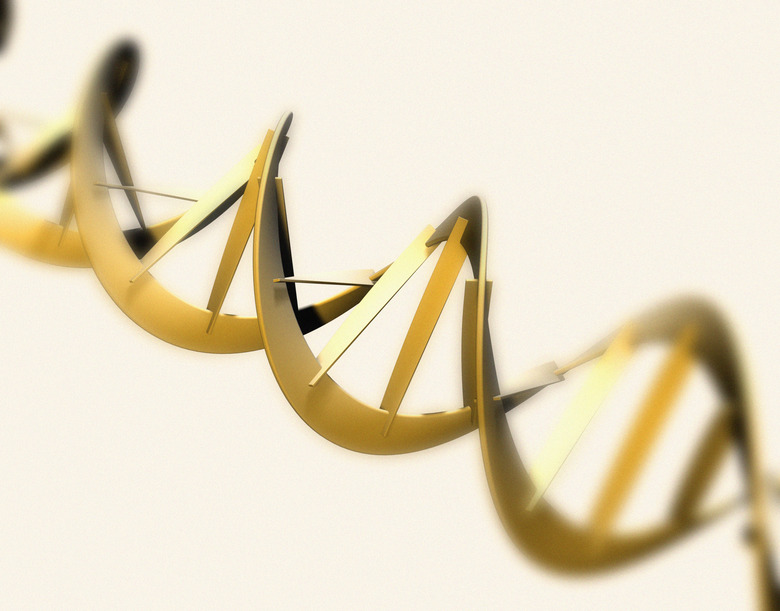The Three Ways That A Molecule Of RNA Is Structurally Different From A Molecule Of DNA
Ribonucleic acid (RNA) and deoxyribonucleic acid (DNA) are molecules that can encode information that regulates the synthesis of proteins by living cells. DNA contains the genetic information passed down from one generation to the next. RNA has several functions, including forming the cell's protein factories, or ribosomes, and transmitting copies of DNA information to the ribosomes. DNA and RNA differ in their sugar content, their nucleobase content and their three-dimensional structure.
Sugars
Sugars
DNA and RNA both contain a backbone of repeating sugar and phosphate units. The sugar found in RNA is ribose, a five-carbon ring with the formula C5H10O5. A hydroxyl group, or OH, hangs off four of the five ribose carbons, while a doubly bonded oxygen binds to the remaining carbon. DNA's sugar, deoxyribose, is similar to ribose, except that one hydroxyl group is placed by a hydrogen atom, giving a formula of C5H10O4. In DNA and RNA, the carbon atoms are numbered 1' to 5'. A nucleobase attaches to the 1' carbon, while phosphate groups link to the 2' and 5' carbons.
Nucleobases
Nucleobases
A nucleobase is a single- or double-ringed molecule containing nitrogen. One of four different nucleobases hangs off each sugar molecule in a nucleic acid. Both DNA and RNA use the nucleobases cytosine, guanine and adenine. However, the fourth DNA nucleobase is thymine, whereas RNA uses uracil instead. The sequence of the bases along certain sections of a nucleic acid, known as the genes, controls the content of the proteins that the cell manufactures. Each triplet of nucleobases translates into a particular amino acid, which is the building block of protein.
Overall Structure
Overall Structure
Although exceptions exist, DNA is usually a double-stranded molecule and RNA is usually single-stranded. The two DNA strands form the famous double-helix structure that resembles a spiral staircase. Hydrogen bonds between corresponding pairs of nucleobases hold the two DNA strands together, along with the assistance of special proteins known as histones. RNA forms single helices that are less tightly compressed than are DNA molecules. The extra stability of the DNA double helix allows very long molecules to form, containing millions of nucleoside bases. However, DNA is more vulnerable to ultraviolet light damage than is RNA.
Functional Differences
Functional Differences
In addition to the structural differences, RNA fulfills a wider set of functions than does DNA. The cell synthesizes RNA using sections of chromosomes as a template. Messenger RNA carries a transcript of a DNA gene to the ribosome, which is composed of ribosomal RNA and proteins. The ribosome reads the messenger RNA and recruits transfer RNAs, which act as tiny tugboats hauling the required amino acids to the ribosome. Another type of RNA helps control the transcription of DNA to RNA. DNA's function is to faithfully maintain and transmit the genetic information of the individual, allowing the cell's machinery to use the information to build proteins.
References
Cite This Article
MLA
Finance, Eric Bank, MBA, MS. "The Three Ways That A Molecule Of RNA Is Structurally Different From A Molecule Of DNA" sciencing.com, https://www.sciencing.com/three-ways-molecule-rna-structurally-different-molecule-dna-22993/. 24 April 2017.
APA
Finance, Eric Bank, MBA, MS. (2017, April 24). The Three Ways That A Molecule Of RNA Is Structurally Different From A Molecule Of DNA. sciencing.com. Retrieved from https://www.sciencing.com/three-ways-molecule-rna-structurally-different-molecule-dna-22993/
Chicago
Finance, Eric Bank, MBA, MS. The Three Ways That A Molecule Of RNA Is Structurally Different From A Molecule Of DNA last modified August 30, 2022. https://www.sciencing.com/three-ways-molecule-rna-structurally-different-molecule-dna-22993/
